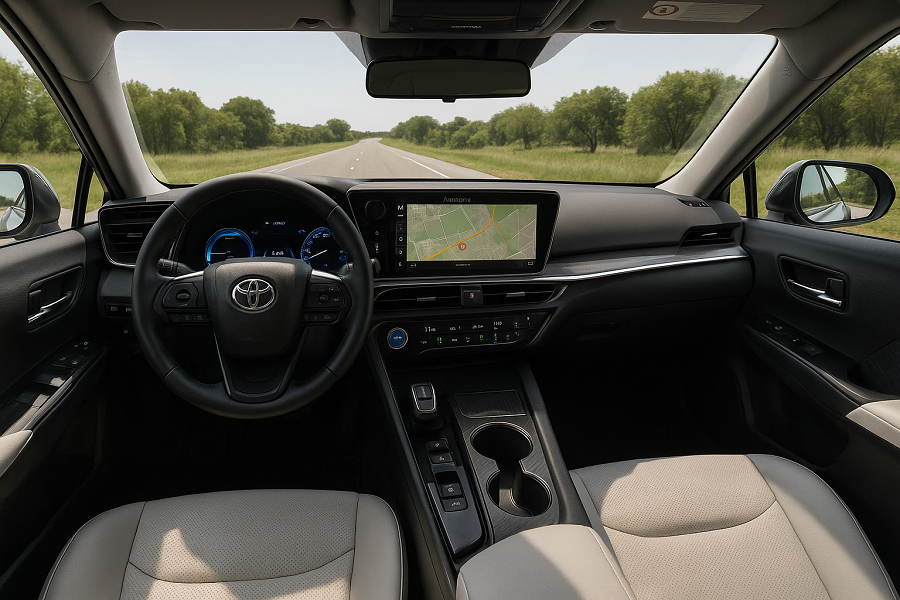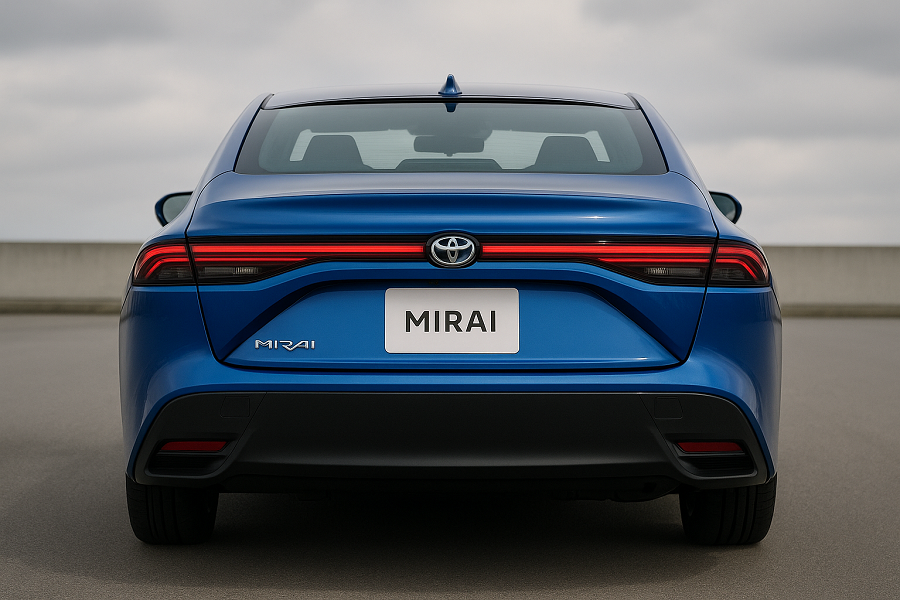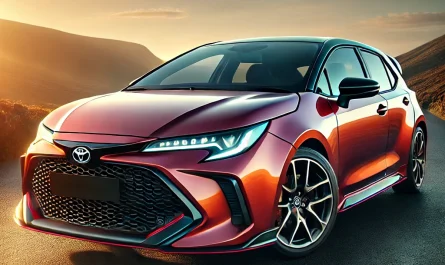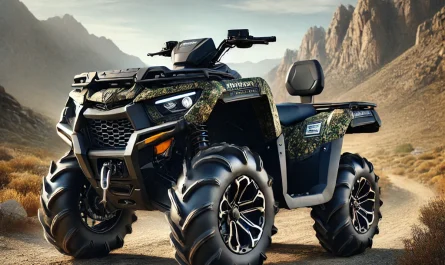The Toyota Mirai stands out as a groundbreaking hydrogen fuel cell car in an automotive landscape dominated by battery electric vehicles. Launched as Toyota’s flagship fuel cell electric vehicle, the Mirai represents a bold step toward sustainable mobility. Unlike traditional cars that burn gasoline or diesel, this hydrogen car uses advanced technology to produce electricity from hydrogen, emitting only water vapor from its tailpipe. As concerns about climate change grow, the Toyota Mirai highlights why hydrogen could play a key role in reducing emissions without sacrificing convenience.
In the broader automotive world, the Mirai is important because it challenges the status quo. While electric vehicles (EVs) like those from Tesla grab headlines, hydrogen fuel cell vehicles offer quick refueling times similar to filling up a gas tank and longer ranges in some cases. Toyota, a leader in hybrid technology with the Prius, extends its eco-friendly legacy here. This Toyota Mirai review explores its features, specs, and real-world appeal, helping you decide if it’s the right fit for a greener future.
History & Background
Toyota’s journey with hydrogen fuel cell technology began in 1992, long before the Mirai hit the roads. The company experimented with early prototypes, like the EVS13 in 1996, which used a metal hydride tank for hydrogen storage. By 2001, Toyota showcased concepts such as the FCHV-4 and FCHV-5 at the Tokyo Motor Show, blending fuel cells with hybrid systems for better efficiency.
The origins of the Toyota Mirai trace back to the FCV-R concept unveiled in 2011 and the FCV concept in 2013. These designs emphasized a sleek look with large grilles for air intake, essential for the fuel cell process. Toyota aimed to make fuel cells affordable, targeting a 95% cost reduction from earlier models like the 2008 FCHV-adv.
The global launch started in Japan in December 2014, priced at about $57,400 before subsidies. Initial sales targeted government and corporate buyers, with demand quickly outpacing supply. The U.S. followed in August 2015, starting at $57,500, but limited to California due to the hydrogen infrastructure. Europe saw launches in September 2015, beginning in the UK and expanding to Germany, Denmark, and others. Canada joined in 2018, focusing on Quebec.
Key developments include the second-generation Mirai in 2020, which switched to rear-wheel drive and achieved a Guinness World Record for traveling 1,360 km on one tank in 2021. By November 2022, global sales reached over 21,000 units, with the U.S. leading at about 11,000.
Design & Styling
The Toyota Mirai’s exterior design highlights a low, wide stance that gives it a premium, futuristic appeal. Its sleek lines and large grille not only look modern but also serve a functional purpose: drawing in air for the fuel cell. For 2025, the Mirai features 19-inch aluminum alloy wheels and LED headlights, enhancing its aerodynamic profile.
Inside, the Mirai offers a comfortable, upscale cabin reminiscent of a Lexus. Soft-touch materials, heated seats, and ample legroom make it ideal for daily drives or longer trips. The interior seats five comfortably, with a quiet ride thanks to excellent sound insulation.
The technology and infotainment system shine with a 12.3-inch touchscreen, supporting Apple CarPlay and Android Auto. A premium JBL audio system with 14 speakers delivers crisp sound, while wireless charging and multiple USB ports keep devices powered.
Hydrogen Fuel Cell Technology Explained
Hydrogen fuel cell technology powers the Toyota Mirai by combining hydrogen gas with oxygen from the air to create electricity. This happens in a fuel cell stack: hydrogen enters one side, oxygen the other, and they react to produce electricity, heat, and water. The electricity then drives an electric motor, propelling the car.
Unlike battery electric vehicles (EVs), which store energy in large batteries and need hours to recharge, hydrogen cars like the Mirai refuel in about five minutes at a station. EVs rely on plugs and grids, while fuel cell electric vehicles use hydrogen tanks and generate power on the go.
Advantages include zero tailpipe emissions, quick refueling, and potentially longer ranges. Challenges? Hydrogen production often uses natural gas, though renewable methods are growing. Infrastructure is limited, and costs can be higher upfront.
Toyota Mirai Performance & Driving Experience
The 2025 Toyota Mirai delivers 182 horsepower and 221 lb-ft of torque from its electric motor, powered by the fuel cell. It’s rear-wheel drive, offering smooth acceleration and a refined ride. Owners describe it as quiet and responsive, handling city streets and highways with ease.
The driving range reaches up to 402 miles on a full tank, with refueling taking just minutes, far quicker than charging an EV. Comfort comes from a well-tuned suspension that absorbs bumps, making it feel luxurious.
Toyota Mirai Models & Trims
For 2025, Toyota simplifies the lineup to a single XLE trim, dropping the previous Limited option. This move adds value by including features like panoramic view monitors as standard.
The XLE comes with 19-inch alloy wheels, heated power-folding mirrors, keyless entry, and an auto-dimming rearview mirror. Inside, you’ll find dual-zone climate control, heated front seats, and a 12.3-inch infotainment screen.
Compared to older models, the 2025 focuses on essentials, making it more accessible without sacrificing tech.

Toyota Mirai Specs (Detailed Breakdown)
Here’s a detailed look at the Toyota Mirai specs for 2025:
- Dimensions: Length: 195.8 inches; Width: 74.2 inches; Height: 57.9 inches; Wheelbase: 114.9 inches.
- Weight: Curb weight around 4,255 pounds.
- Powertrain: 182 hp electric motor; 221 lb-ft torque; Rear-wheel drive.
- Fuel Cell: Toyota Fuel Cell System with 113 kW output.
- Battery: 1.2 kWh lithium-ion battery for energy storage.
- Hydrogen Tanks: Three carbon-fiber-reinforced tanks holding about 5.65 kg of hydrogen.
- Transmission: Single-speed automatic.
- Suspension: Independent front and rear for smooth handling.
These specs make the Mirai comparable in size to a midsize sedan like the Camry, but with advanced eco-tech.
Fuel Economy & Efficiency
The Toyota Mirai achieves an EPA-estimated 76 MPGe in the city and 71 MPGe on the highway, making it highly efficient. MPGe measures how far it goes on the energy equivalent of a gallon of gasoline.
With a full tank, expect up to 402 miles of range, competitive with many EVs but without long charge times. Efficiency shines in mixed driving, where regenerative braking recaptures energy.
Toyota Mirai Safety Features
Safety is a priority with the Toyota Safety Sense 3.0 standard on the 2025 Mirai. This includes forward collision warning, automatic emergency braking, and pedestrian detection.
Other features: Lane departure alert with steering assist, adaptive cruise control, and road sign assist. Crash test ratings are strong, with a five-star Euro NCAP score for the second-generation model.
Hydrogen-specific safety includes sensors that detect leaks and shut off tanks in collisions. Eight airbags and a reinforced structure add protection.
Toyota Mirai Price & Availability
In the US, the 2025 Toyota Mirai price starts at $51,795 for the XLE trim. Incentives include $15,000 in complimentary fuel for purchases (6 years) or leases (3 years). Federal rebates up to $7,500 and state incentives like California’s $4,500 can lower costs.
In Europe, prices hover around €60,000, varying by country. Japan starts at about ¥7 million. Availability is limited to areas with hydrogen stations, primarily California in the US, and select regions in Europe and Japan.
Lease options often include fuel credits, making it more affordable than buying outright.
Hydrogen Infrastructure
Refueling the Toyota Mirai requires hydrogen stations, which pump compressed hydrogen like gasoline. In 2024, over 1,000 stations operated worldwide, with 125 new ones added that year: 42 in Europe, 30 in China, and 25 in South Korea.
Globally, infrastructure is expanding: The market could reach 1,562 stations by 2030, a six-fold increase. In the US, California leads with about 74 public stations. Plans include ultra-fast tech and digital interfaces for heavy-duty use.
Pros & Cons of Toyota Mirai
Pros:
- Eco-friendly with zero tailpipe emissions.
- Quick refueling in minutes.
- Smooth, quiet drive with innovative tech.
- Generous incentives and fuel credits.
Cons:
- Limited hydrogen stations restrict usability.
- Higher upfront price compared to some EVs.
- Niche market, mainly in specific regions.
- Potential issues with hydrogen availability.
Toyota Mirai vs. Competitors
Compared to the Honda Clarity Fuel Cell (discontinued in 2021), the Mirai offers a longer 402-mile range versus the Clarity’s 360 miles. The Hyundai Nexo, another hydrogen car, has a 380-mile range and 161 hp, but the Mirai edges it in torque at 221 lb-ft.
Against Tesla EVs like the Model 3, the Mirai refuels faster but lacks widespread charging networks. Tesla’s battery EVs are cheaper to operate in most areas, with broader availability, but hydrogen suits those needing quick stops. Strengths: Mirai’s ride is more refined; weaknesses: Infrastructure lags behind EV chargers.

Environmental Impact
The Toyota Mirai’s zero-emission operation reduces greenhouse gases, emitting only water. It plays a role in a hydrogen economy, where renewable hydrogen production could cut reliance on fossil fuels.
Using clean hydrogen helps lower overall carbon footprints, aligning with global sustainability efforts.
Future of Toyota Mirai & Hydrogen Cars
Toyota’s long-term hydrogen strategy positions it as a key fuel for decarbonization, alongside hybrids and EVs. The company aims for carbon neutrality, investing in hydrogen for heavy-duty sectors.
Predictions see the hydrogen market growing, with more stations by 2030. The Mirai fits Toyota’s goals by advancing FCEV tech and reducing emissions.
Customer Reviews & Public Perception
Owners praise the Mirai’s smooth ride and incentives, with one saying, “Got $20k off plus rebates feels like a steal.” However, infrastructure frustrations are common: “Weeks without reliable fueling are annoying.”
Public reception is positive for its innovation but tempered by availability issues. Sales dipped in 2024, yet loyal fans see it as the future.
Conclusion
The Toyota Mirai is a vital player in the shift to sustainable vehicles, offering a practical alternative to battery EVs with its hydrogen fuel cell tech. While challenges like infrastructure persist, its benefits in range and refueling make it appealing for eco-conscious drivers.
Looking ahead, as hydrogen expands, cars like the Mirai could become mainstream, driving us toward a cleaner planet. If you’re in a supported area, it’s worth considering for its blend of innovation and everyday usability.


